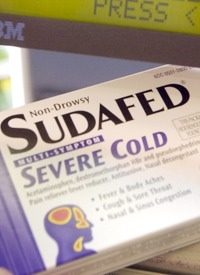
Back in 2005 Congress passed a law, which President George W. Bush then signed, forcing sellers of products containing the decongestant pseudoephedrine to store such medicines behind the counter and dole them out to customers, logging each purchase to ensure that no one buys more than the feds’ arbitrarily-set limits on these drugs. The idea was to prevent people from purchasing large quantities of the medications and turning them into methamphetamines.
Taking things a step further, states later mandated electronic tracking of pseudoephedrine purchases, in some cases even notifying the police of attempts to exceed the limit.
So, as Dr. Phil might say, how’s that workin’ out for ya, feds?
To the shock only of those with neither basic historical knowledge nor common sense, the Associated Press reports:
Electronic systems that track sales of the cold medicine used to make methamphetamine have failed to curb the drug trade and instead created a vast, highly lucrative market for profiteers to buy over-the-counter pills and sell them to meth producers at a huge markup.
An Associated Press review of federal data shows that the lure of such easy money has drawn thousands of new people into the methamphetamine underworld over the last few years.
Yes, just as prohibition of alcohol brought new criminal gangs into existence and turned ordinary Americans into lawbreakers, so has the near prohibition of pseudoephedrine-containing products such as Sudafed. Yet, says the AP:
Police and federal agents never expected that electronic tracking would actually draw more people into the criminal enterprise surrounding meth.
“Law enforcement was surprised,” St. Louis County Sgt. Tom Murley said. “People that normally wouldn’t cross the line are willing to do so because they think it’s such a sweet deal, and because of the economy.”
How sweet is the deal? The AP reports that pseudoephedrine buyers “can buy a box of pills for $7 to $8 and sell it for $40 or $50.” Jason Grellner, a Franklin County, Missouri, detective and former president of the Missouri Narcotics Officers Association, asked rhetorically, “Where else can you make a 750 percent profit in 45 minutes?”
With individuals banned from purchasing the number of pills they desire, “meth producers recruit friends, acquaintances, strangers and even their own children to buy pills,” says the AP — a stark contrast to the pre-restriction era in which meth production “was often a one-person operation.” Jeffrey Tucker of the Ludwig von Mises Institute, who has been writing about what he calls the “war on Sudafed” for years, notes that this outcome “seems obvious in retrospect,” though even he did not anticipate it. It is little different from the rise of gangsters during Prohibition, a direct result of the profits to be had from bootlegging and the large operations needed to produce and distribute alcoholic beverages under the circumstances.
Ingenious humans have found other ways of circumventing the pseudoephedrine restrictions. Individuals can purchase a package of cold pills and a two-liter bottle of soda without setting off any government alarms; they then use the bottle and the pills to produce small amounts of meth via the “shake-and-bake” method. Alternatively, meth can simply be imported from Mexico, whose drug cartels, lured by the profits prohibition has created, are supplying “an increasing amount of meth,” according to the AP.
The result of all this is that “meth-related activity is on the rise again nationally, up 34 percent in 2009, the year with the most recent figures,” the AP writes. “That number includes arrests, seizures of the drug and the discovery of abandoned meth-production sites.” Moreover, the report continues, “the increase was higher in the three states that have electronically tracked sales of medication containing pseudoephedrine since at least 2008. Meth incidents rose a combined 67 percent in those states — 34 percent in Arkansas, 65 percent in Kentucky and 164 percent in Oklahoma.”
This is a reversal of the trend that began when states started requiring electronic tracking of pseudoephedrine purchases, after which the number of meth incidents dropped precipitously. However, as even Grellner admitted, the tracking systems “invite more people into the criminal activity because the black market price of the product becomes so much more profitable.” Hence, meth producers figured out ways to get around the government’s restrictions, and meth incidents are climbing again.
Of course, there are always those — principally in government — who refuse to believe that eventualities that contradict the stated aims of government policies are cause for reevaluating those policies. Thus, says the AP, “advocates of tracking say the rise in meth incidents indicates success, not failure.” One of those advocates is Sheriff Keith Cain of Daviess County, Ky., who told the AP that the increase in meth incidents in the last couple of years has come about in part “because of law enforcement’s ability to track and locate the people producing meth.” Yet the AP points out that production (and the government’s knowledge of it) isn’t the only thing on the rise: “In September, the annual report from the federal government’s Substance Abuse and Mental Health Services Administration showed a 60 percent one-year increase in the number of meth users.”
Meth prohibition and pseudoephedrine restrictions, therefore, have led to an increase in both meth production and meth use. But to those who avert their eyes from evidence of government failure, the unintended consequences of one government intervention are cause for just one thing: more government intervention.
It thus comes as no great surprise that states, and even localities, are now pushing for even greater restrictions on cold-medicine purchases. Oregon and Mississippi now require customers to obtain a prescription to buy products containing pseudoephedrine. In Missouri, “more than a dozen communities have passed their own prescription laws,” the AP reports, and the “governor is asking [state] lawmakers to follow suit.” Oregon’s law, passed in 2006, has met with significant success; but one suspects that, given time, meth users will find ways to get what they want anyway, even if it means getting their fix from south of the border.
Government prohibition of substances always has the same, predictable effects: a black market, more crime, and ever greater restrictions on the law-abiding. The war on Sudafed — not to mention meth — should be severely curtailed if not abolished. The cost in liberty is nothing to sneeze at.
Photo: AP Images



